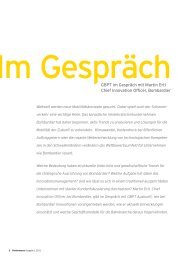PERF RMANCE 04 - The Performance Portal - Ernst & Young
PERF RMANCE 04 - The Performance Portal - Ernst & Young
PERF RMANCE 04 - The Performance Portal - Ernst & Young
Create successful ePaper yourself
Turn your PDF publications into a flip-book with our unique Google optimized e-Paper software.
In demographic terms, rural India is more<br />
advantageously placed, with the number of<br />
working population there outnumbering the<br />
total urban population (see Table 3).<br />
Table 3. Age distribution of rural<br />
population in India<br />
Age group<br />
Population (rural) mn<br />
Greater than 70 22<br />
61 to 70 33<br />
51 to 60 56<br />
41 to 50 77<br />
31 to 40 107<br />
21 to 30 127<br />
Less than 20 311<br />
Total working population<br />
A clear demonstration of the importance<br />
of rural India is shown by looking at the<br />
number of organizations which derive a<br />
significant proportion of their overall sales<br />
from outside of the country’s largest towns<br />
and cities (see Table 4).<br />
Table 4. Company presence in rural<br />
markets<br />
concentrated. For example, there are<br />
4,700 towns and over 600,000 villages<br />
spread across the length and breadth of<br />
India. Yet more than half of the population<br />
and approximately 60% of the total rural<br />
wealth is concentrated in just 17% of these<br />
same villages.<br />
Given these characteristics, deploying an<br />
optimal distribution structure for such<br />
a market becomes a challenge for any<br />
company, especially those which have been<br />
geared toward managing a distribution<br />
chain predominantly in urban markets. For<br />
instance, decisions on distribution networks<br />
have to take into account both the size of<br />
the potential market as well as the cost<br />
required to service the dispersed demand<br />
that rural India represents. <strong>The</strong> two maps<br />
(see Map 1 and Map 2) demonstrate this<br />
point. Map 1 is an evaluation of all districts<br />
in a particular state MP (Madhya Pradesh)<br />
on the basis of market potential and the<br />
second is based on cost-to-serve. It is clear<br />
that both present very different outcomes<br />
for any district.<br />
Company Category % sales from<br />
rural markets 4<br />
Hindustan Household<br />
45%<br />
Unilever products<br />
Hero Honda Two wheelers 60%<br />
Dabur Personal<br />
40%<br />
products<br />
Dish TV Media 33%<br />
TVS Two wheelers 50%<br />
However, while rural India has tremendous<br />
market potential, there are some inherent<br />
characteristics which make it significantly<br />
different from urban India. In particular,<br />
the way in which the population is<br />
simultaneously dispersed and yet<br />
“ Distribution equity refers to<br />
the maturity and flexibility of a<br />
business’s distribution network.”<br />
4 Publically available information






